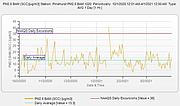Wood Stove Changeout Program comes to a close
KELLOGG — For the last five years, the Idaho Department of Environmental Quality has offered to replace qualifying old wood stoves in the West Silver Valley for free.
After replacing nearly 200 of these outdated stoves in homes, shops and businesses inside the attainment area, IDEQ Regional Airshed Coordinator Dan Smith said the program is just about to wrap up.
While some previously accepted applicants are still awaiting installation and others are still being considered for approval, the final deadline to apply passed last week.
Thanks to an Environmental Protection Agency airshed grant awarded to IDEQ in 2016, Smith has overseen the replacement of 189 stoves, chimneys and hearths. Broken down, 31.2% were gas stoves, 58.7% were non-catalytic wood stoves, 7.4% were catalytic and hybrid wood stoves, and 2.6% were pellet stoves.
Originally planned to end in 2020, the program had been so successful that it was extended to 2021.
On top of the successful number of changeouts, Smith explains that the overall goal of improving the West Silver Valley's air quality was accomplished as well.
"The neat thing about this is that we see a steady decrease in the emissions out there since we started…If you look at how many stoves we have been putting in annually and the improvements in the air quality, there's a pretty strong correlation there."
In 2015, the EPA designated the West Silver Valley Airshed (which runs from Cataldo to Big Creek. Pine Creek and portions of the North Fork also applied) as a nonattainment area for PM2.5 (fine particulate matter), meaning it had violated the federal health-based annual standard for this pollutant. Since then, efforts like the wood stove changeout program have been successful and IDEQ submitted a request to the EPA to re-designate the area as "in attainment."
According to PM2.5 data collected by IDEQ's Pinehurst monitoring station, the average amount of micrograms of gaseous pollutant per cubic meter of ambient air (µg/m3) measured during peak stove usage months (winter) has reduced since the program began.
For example, from Oct. 2, 2015, to March 2, 2016, the average PM2.5 reading was 17.7 from the Pinehurst station. Fast forward to 2020-2021 during the same time frame, the average reading showed 13.3.
Another useful statistic was the number of recorded National Ambient Air Quality Standards Excursions, or the number of days that the PM2.5 levels went above 35.
From Oct. 2, 2016, to March 2, 2017, there were 16 NAAQS Excursions recorded. In the same 2020-2021 time period though, the number of excursions dropped to one.
Considering other factors such as more residents using proper devices, proper fuels, practicing proper behaviors, participating in gas conversions and experiencing generally milder winters (especially this last one); Smith is aware that the improved air quality can't be solely attributed to the changeout program. The data over the last five years of the program though certainly shows it has been a factor.
Smith attributes much of the program's success to taking a community-mind approach.
"Educating people, talking to people, developing that personal relationship had a lot to do with that success," he said.
It also didn't hurt that the stoves that the program offered were top-notch that burned cleaner and hotter than the ones they were replacing.
During the colder winter months when the area is susceptible to frequent inversions, fine particulate matter from woodstoves and other sources can be trapped in the area. The new, cleaner burning, wood stoves only release 3.5 grams per hour (gph) of particulate, compared to the older/outdated ones that release around 35 gph.
Elevated levels of particulate matter can affect the overall health of area residents — particularly children with chronic health conditions and the elderly.
Looking forward, Smith and the IDEQ hope to work with Shoshone County in reducing the number of slash piles by both the county and its residents.





